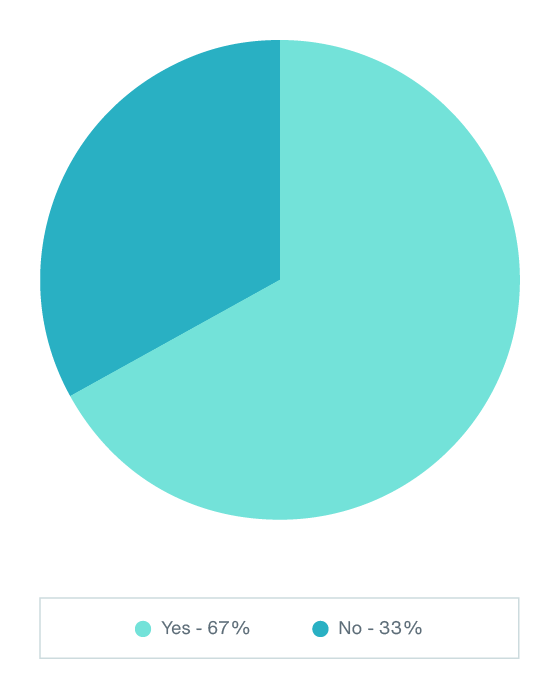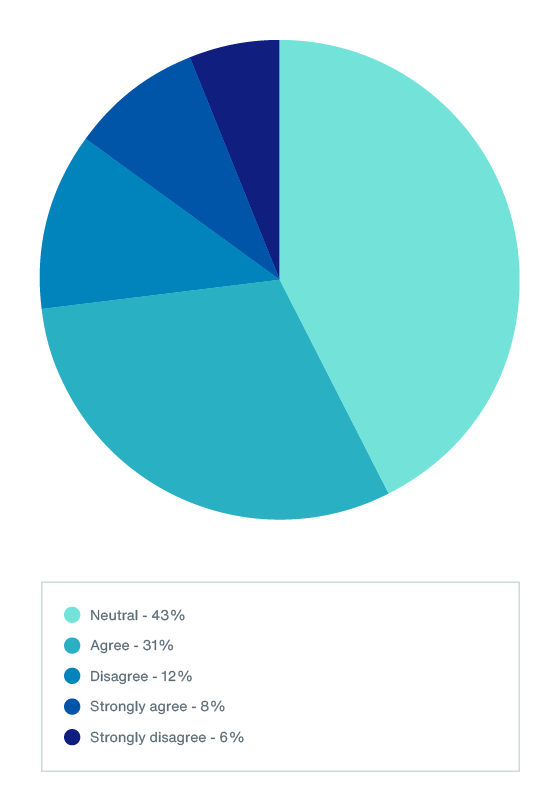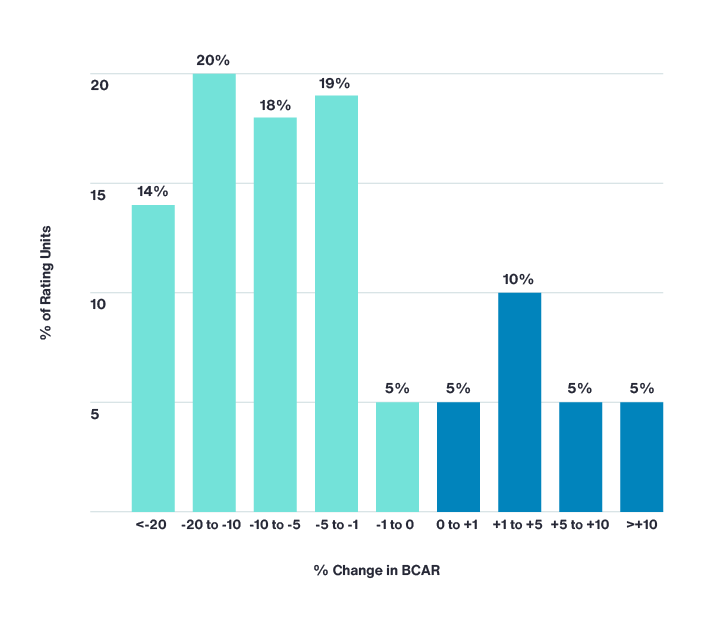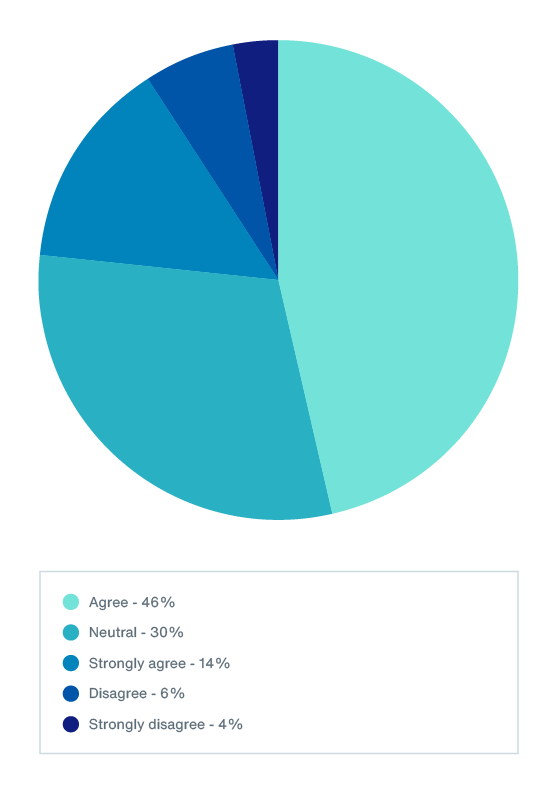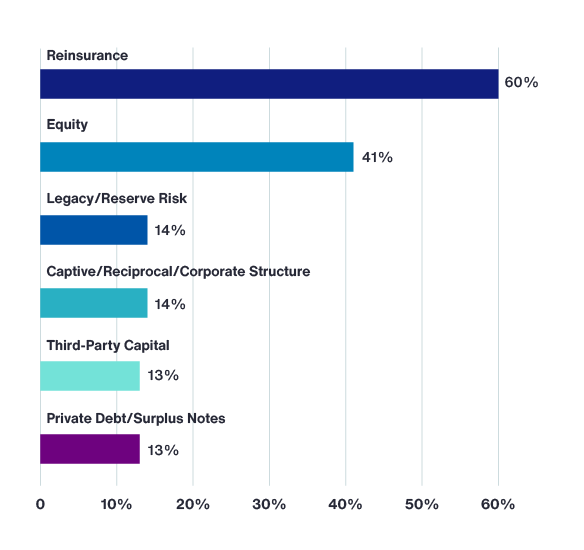Insurers Seek Risk Transfer Solutions to Offset Higher Retentions and Resume Growth

The challenges of 2023 eroded the buffers that many insurers had previously enjoyed, bringing an increased focus on capital management and a variety of capital sources according to Aon’s capital poll.
Key Takeaways
-
60 percent of companies would benefit from additional reinsurance to support growth
-
39 percent of respondents stated their companies feel pressure to increase capital; this is evidenced by 75 percent of companies experiencing a drop in BCAR over the last eight months
-
Insurers responded that reinsurance and equity will be their primary future capital sources followed by third-party capital
With robust pricing levels in many primary insurance markets, and huge unmet need, the outlook for the insurance sector is looking more positive. But insurers are not out of the woods yet.
Although still adequately capitalized overall, the challenges of 2023 eroded the buffers that many insurers had previously enjoyed. Aon’s Capital Poll focused on insurers’ risk appetite, their need for additional capital, and their attitudes towards current and future capital sources. It reveals that a significant proportion are under pressure from stakeholders, including ratings agencies, to bolster capital. The poll also shows that the majority are now operating with higher retentions, resulting in increased earnings volatility.
As such, there is an increased focus on capital management with insurers reporting in Aon’s Capital Poll that they are exploring a variety of capital sources as demands on capital continue to evolve, and with attractive growth opportunities emerging.
Higher Retentions Led to Increased Volatility
Given the challenging reinsurance renewal of January 2023, many primary insurers have seen increases in retention levels: Nearly 70 percent of Aon’s Capital Poll respondents reported that their retentions increased for programs renewing in 2023. This has led to significant volatility in primary insurers’ results over the year, a situation not helped by natural catastrophe losses – which remained above the historical average in 2023. Severe convective storm (SCS) activity was particularly impactful, with Aon estimating that global SCS economic losses reached $94 billion that year.
Exhibit 1: Did you increase your reinsurance retentions during your 2023 renewal?
Insurers Under Pressure to Boost Capital
Rating agencies have noted a significant divergence between the results of commercial and personal lines insurers. The excess and surplus lines segment has boosted the performance metrics of the commercial lines composite, while personal lines have faced difficulties reaching rate adequacy in light of regulatory hurdles. AM Best continues to have negative outlooks on the U.S. personal lines market segment, while S&P has an overall negative outlook on the entire U.S. property and casualty sector. Fitch has a neutral outlook on both segments but does not expect a return to profitability on the primary side until 2025. In June Moody’s moved to a stable outlook on personal lines as profitability improves with rate increases earning into results.
During 2023, there was a noted negative bias in ratings activity, with 12 percent of S&P ratings on a negative outlook compared to 6 percent positive, three downgrades and no upgrades. Meanwhile, in 2023 AM Best’s downgrades were double its upgrades1.
Exhibit 2: Ratings Outlooks
| Line of Business | AM Best | Fitch | S&P2 | Moody’s |
|---|---|---|---|---|
| Personal Lines | Negative | Neutral | Negative | Stable |
| Commercial Lines | Stable | Neutral | Negative | Stable |
| Reinsurance | Positive | Improving | Stable | Stable |
The divergence between commercial and personal lines writers can be seen in the results of Aon’s Capital Poll. Slightly under 40 percent of respondents reported they were feeling pressure to increase capital levels from a variety of stakeholders. While the industry overall remained adequately capitalized, capital metrics deteriorated, especially for regional insurers. Companies faced not only investment volatility, but also elevated insured losses from natural catastrophe events in 2023.
Exhibit 3: Are you feeling pressure to increase your capital level from rating agencies, regulators, investors or internally to achieve sufficient returns?
On the rating agency side, Aon has seen a notable erosion in insurers’ capital buffers as assessed by AM Best’s Capital Adequacy Ratio (BCAR) score. Between August 2023 and March 2024 AM Best updated 316 rating units, of which more than 75 percent experienced a decline in their BCAR. Changes to AM Best’s balance sheet strength assessment, linked to BCAR declines, were among the leading triggers for negative rating action from the rating agency in 2023. Aon expects that access to diverse sources of capital will be an area of rating agency focus in 2024.
Exhibit 4: BCAR score changes for 316 rating units
Additional Capital to Supporting Growth Opportunities
Aside from revealing that some insurers intend to shore-up balance sheets to improve financial strength ratings, the Capital Poll asked respondents whether additional capital would help them to meet growth targets. Sixty percent of respondents indicated that their company would materially benefit from additional capital to support growth opportunities. Although profitability for many primary insurers was below their cost of capital in 2023, disciplined underwriting is expected to continue, and companies are seeking opportunities to take advantage of compounding rate increases.
Exhibit 5: To support your company’s growth, both organic and inorganic, would you materially benefit from additional capital?
Insurers face a challenging balancing act, given higher retentions and elevated reinsurance costs, while maintaining rating agency capital adequacy benchmarks – all the while, not missing out on the opportunity to grow in today’s market.
Reinsurance Viewed as Top Source of Capital
The Capital Poll highlighted that Reinsurance (60 percent) was the most common source of capital used by respondents, followed by equity (41 percent) as respondents could select multiple capital forms. Given the higher retentions experienced on the primary side throughout 2023, it is not surprising that insurers would seek to cover those gaps when possible. Meanwhile, alternative reinsurance capital surpassed USD100 billion in 2023, with insurers engaging with third-party investors for additional capacity.
Exhibit 6: What forms of capital did you use in 2023?
Reinsurance (56 percent) and equity (32 percent) were also shown to be the primary future capital sources selected by respondents, followed by third-party capital. The lower level of interest in future legacy solutions may change given reserve development trends experienced in 2023 and that reserve strengthening on liability lines, driven by social inflation, is a continuing area of concern in 2024.
Exhibit 7: What forms of capital are you exploring in 2024?
Delivering Capital Solutions to Insurers
The results of the Capital Poll confirm Aon’s strategic approach to bringing a range of new capital sources and solutions to insurers. Throughout 2023 and into 2024, Aon has made it a priority to deliver greater volumes of capital globally, helping insurers reduce reported volatility, and build business resilience – particularly when faced with rating agency action. This additional capital has served to strengthen their position in the marketplace, liberating insurers from balance sheet constraints and allowing for better business decisions.
About Aon’s Capital Poll
In the second half of 2023, Aon surveyed attendees at key industry conferences in the U.S., Europe and Asia Pacific to elucidate the industry’s approach towards capital utilization globally. With more than 200 respondents, Aon’s Capital Poll focused on companies’ risk appetite, their need for additional capital, and their attitudes towards current and future capital sources.
1 S&P Global Ratings, U.S. Property/Casualty Insurance Sector View 2024, Jan 31. 2024.
2 S&P has an overall negative outlook on the US P&C segment.
General Disclaimer
This document is not intended to address any specific situation or to provide legal, regulatory, financial, or other advice. While care has been taken in the production of this document, Aon does not warrant, represent or guarantee the accuracy, adequacy, completeness or fitness for any purpose of the document or any part of it and can accept no liability for any loss incurred in any way by any person who may rely on it. Any recipient shall be responsible for the use to which it puts this document. This document has been compiled using information available to us up to its date of publication and is subject to any qualifications made in the document.
Terms of Use
The contents herein may not be reproduced, reused, reprinted or redistributed without the expressed written consent of Aon, unless otherwise authorized by Aon. To use information contained herein, please write to our team.
Aon's Better Being Podcast
Our Better Being podcast series, hosted by Aon Chief Wellbeing Officer Rachel Fellowes, explores wellbeing strategies and resilience. This season we cover human sustainability, kindness in the workplace, how to measure wellbeing, managing grief and more.
Aon Insights Series Asia
Expert Views on Today's Risk Capital and Human Capital Issues
Aon Insights Series Pacific
Expert Views on Today's Risk Capital and Human Capital Issues
Aon Insights Series UK
Expert Views on Today's Risk Capital and Human Capital Issues
Client Trends 2025
Better Decisions Across Interconnected Risk and People Issues.
Construction and Infrastructure
The construction industry is under pressure from interconnected risks and notable macroeconomic developments. Learn how your organization can benefit from construction insurance and risk management.
Cyber Labs
Stay in the loop on today's most pressing cyber security matters.
Cyber Resilience
Our Cyber Resilience collection gives you access to Aon’s latest insights on the evolving landscape of cyber threats and risk mitigation measures. Reach out to our experts to discuss how to make the right decisions to strengthen your organization’s cyber resilience.
Employee Wellbeing
Our Employee Wellbeing collection gives you access to the latest insights from Aon's human capital team. You can also reach out to the team at any time for assistance with your employee wellbeing needs.
Environmental, Social and Governance Insights
Explore Aon's latest environmental social and governance (ESG) insights.
Q4 2023 Global Insurance Market Insights
Our Global Insurance Market Insights highlight insurance market trends across pricing, capacity, underwriting, limits, deductibles and coverages.
Regional Results
How do the top risks on business leaders’ minds differ by region and how can these risks be mitigated? Explore the regional results to learn more.
Human Capital Analytics
Our Human Capital Analytics collection gives you access to the latest insights from Aon's human capital team. Contact us to learn how Aon’s analytics capabilities helps organizations make better workforce decisions.
Human Capital Quarterly Insights Briefs
Read our collection of human capital articles that explore in depth hot topics for HR and risk professionals, including using data and analytics to measure total rewards programs, how HR and finance can better partner and the impact AI will have on the workforce.
Insights for HR
Explore our hand-picked insights for human resources professionals.
Workforce
Our Workforce Collection provides access to the latest insights from Aon’s Human Capital team on topics ranging from health and benefits, retirement and talent practices. You can reach out to our team at any time to learn how we can help address emerging workforce challenges.
Mergers and Acquisitions
Our Mergers and Acquisitions (M&A) collection gives you access to the latest insights from Aon's thought leaders to help dealmakers make better decisions. Explore our latest insights and reach out to the team at any time for assistance with transaction challenges and opportunities.
Natural Resources and Energy Transition
The challenges in adopting renewable energy are changing with technological advancements, increasing market competition and numerous financial support mechanisms. Learn how your organization can benefit from our renewables solutions.
Navigating Volatility
How do businesses navigate their way through new forms of volatility and make decisions that protect and grow their organizations?
Parametric Insurance
Our Parametric Insurance Collection provides ways your organization can benefit from this simple, straightforward and fast-paying risk transfer solution. Reach out to learn how we can help you make better decisions to manage your catastrophe exposures and near-term volatility.
Pay Transparency and Equity
Our Pay Transparency and Equity collection gives you access to the latest insights from Aon's human capital team on topics ranging from pay equity to diversity, equity and inclusion. Contact us to learn how we can help your organization address these issues.
Property Risk Management
Forecasters are predicting an extremely active 2024 Atlantic hurricane season. Take measures to build resilience to mitigate risk for hurricane-prone properties.
Technology
Our Technology Collection provides access to the latest insights from Aon's thought leaders on navigating the evolving risks and opportunities of technology. Reach out to the team to learn how we can help you use technology to make better decisions for the future.
Top 10 Global Risks
Trade, technology, weather and workforce stability are the central forces in today’s risk landscape.
Trade
Our Trade Collection gives you access to the latest insights from Aon's thought leaders on navigating the evolving risks and opportunities for international business. Reach out to our team to understand how to make better decisions around macro trends and why they matter to businesses.
Transaction Solutions Global Claims Study
Better Decisions Across Interconnected Risk and People Issues.
Weather
With a changing climate, organizations in all sectors will need to protect their people and physical assets, reduce their carbon footprint, and invest in new solutions to thrive. Our Weather Collection provides you with critical insights to be prepared.
Workforce Resilience
Our Workforce Resilience collection gives you access to the latest insights from Aon's Human Capital team. You can reach out to the team at any time for questions about how we can assess gaps and help build a more resilience workforce.
Learn More
-

Capability Overview
Capital Optimization for Insurers
Global reinsurer capital declined by 15 percent in 2022, principally driven by substantial unrealized losses on investment portfolios and increased catastrophe losses from secondary perils.
-

Capability Overview
Capital, Pricing and Reserve Models
As the (re)insurance industry tackles inflation, rising catastrophe losses, climate change and geopolitical risks, insurers need financial modeling tools to understand the risks and identify the opportunities to deploy capital efficiently and effectively across the enterprise.
-

Capability Overview
Rating Agency Advisory
As market dynamics and rating agency criteria evolve, insurers need to be better informed of the key metrics that impact their ratings. Insurer balance sheets face mounting pressure from unrealized losses due to rising interest rates, volatile equity market performance and increased frequency and severity of catastrophe events.
